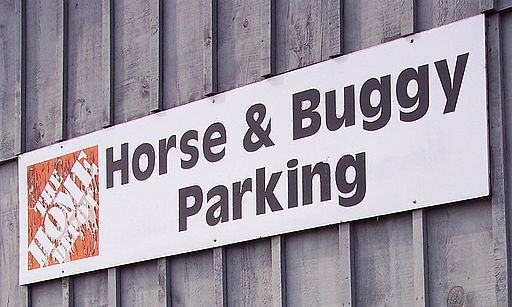The average big-box hardware store is like a small city. They have every piece of hardware or tool imaginable (except, of course, the one you’re looking for). You’ll find no less that 15 aisles of power tools stocked with everything from battery operated screwdrivers to arc welders. To store all these tools, you can purchase the 6-foot-tall rolling toolbox, with a 20-watt stereo, built-in beer chiller, wi-fi connectivity, and a Twitter or Facebook app. One aisle over, there’s row after row of pristine white toilets, occupied by a small army of playing children. Near the back of the store, nestled between endless rows of storm doors and windows is a quaint “grocery” section, as if someone uprooted and transplanted a gas station convenience store, and trimmed away all of the bits that weren’t junk food. Finally, outside the building, is the drive-thru lumber yard, where you drive to the end to purchase your 20 cubic feet of mulch and invariably get stuck behind an idling vehicle abandoned by a socially-clueless DIY-er who either disappeared on an epic quest to find help loading 200 short tons of bagged white river rock into his 1993 Ford Ranger, or more likely, thought it was a convenient parking spot while he left for an 8-week sabbatical on a mountain in Tibet.
Scott loved working in such a store while going to college for an IT degree. He didn’t work on the floor, where the poor retail staff dealt with angry customers trying to negotiate down the price of a few 2x4’s, or trying to return 1000 pounds of tile (which was clearly defective because it shattered when they dropped it on concrete). Scott was the store’s IT tech, doing all the tasks that Bob, the store’s “IT Associate” and self-proclaimed “computer expert”, should know how to do but didn’t.
Scott got an after-hours call that the computer system was entirely down, and Bob couldn’t figure out the problem. This was strange, since Bob was the “expert”. The small server closet, designed and installed by Bob, was supposed to be entirely redundant. The server had a hot spare and both systems had redundant power supplies.
“Scott, glad you’re here!” a panicked cashier greeted him as he ran into the store. “We can’t run any transactions and the customers are getting furious!”
Scott quickly made his way to the small closet in the back of the office area. Both servers were off, with no power at all. Pushing the power buttons did nothing. Meanwhile, he could hear irate customers with access to power tools and sledgehammers berating the helpless cashiers whose registers were offline.
He traced the power cables from the server and facepalmed when he discovered the problem. Each server had two power supplies. The first power supplies were plugged into a nice, long-corded surge protector, which connected to the wall outlet. The backup power supplies were plugged into a $3.50 power strip somebody had pulled from the store’s shelves. Those cords weren’t long enough to reach a separate outlet, thus it was plugged into… the first surge protector!
The room was fairly warm, and with the full load of two “redundant” circuits, the surge protector had overheated and tripped its breaker. Scott rewired the power supplies into an actual redundant fashion, reset the surge protector, and had the registers back up and running within half an hour. He called it a day and went back home.
Until an hour later, when the cashiers called him back in: everything was down again. Now that the servers didn’t die when it got mildly warm in the room, it had turned into a furnace. Bob, the “expert”, was busy trying to fan the heat out with a towel when Scott arrived. Scott set up one of the industrial fans in the store to ventilate the room and called maintenance to get someone to look at the HVAC system.
The fan got the servers cool enough to keep running, but Scott and Bob waited around to see what maintenance found. One of the technicians grabbed them. “Did you know the thermostat was set to 45ºF?”
“What?” Scott blurted.
“Of course,” Bob said. “Computers should be as cold as possible. They run better.”
“Not that cold!” Scott said.
“Well, you can’t keep them that cold,” the tech said. “The AC unit just runs continuously, and the coils get so cold that they start to freeze. Literally- your AC unit is a block of ice right now. Leave it off for a few hours, and then turn it back on at a reasonable temperature.”
That day, Bob and Scott followed their instructions, but Bob remained unconvinced about these warnings. As the seasons transitioned into summer, he cranked the thermostat lower and lower. Through the hottest months of the year, Bob caused six more heat-related outages as he did his best to destroy the AC unit. Fortunately, they worked in a hardware store. Scott installed a lock-box over the thermostat and told Bob that maintenance had done it.


